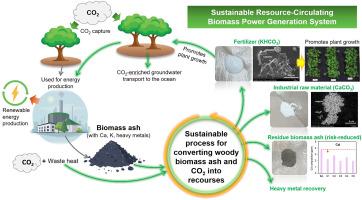Converting woody biomass ash and CO2 into valuable resources via a sustainable chelation approach
IF 10.9
1区 环境科学与生态学
Q1 ENGINEERING, ENVIRONMENTAL
引用次数: 0
Abstract
Efficient valorization of woody biomass ash is essential for advancing sustainable bioenergy systems and supporting a low-carbon circular economy. A key challenge lies in safely managing heavy metals while recovering valuable resources. In this study, we developed a sustainable process for simultaneously producing high-purity potassium fertilizer (KHCO3) and industrial raw material (CaCO3) from woody biomass ash. This is achieved using a recyclable CO2-enriched solution containing a green chelating agent N,N-bis(carboxymethyl)-L-glutamic acid (GLDA), which enhances extraction and selective precipitation of metal ions under mild conditions (<100°C, ambient pressure). The process enables effective CO2 capture and storage, significantly reducing heavy metal Cd, Cu, As, Pb, Zn content in the ash and recovers valuable K and Ca resources. By integrating carbon mitigation with material recycling, this approach provides a practical and scalable pathway toward circular economy implementation in biomass-based power generation.

通过可持续螯合方法将木质生物质灰烬和二氧化碳转化为有价值的资源
木质生物质灰的有效增值对于推进可持续生物能源系统和支持低碳循环经济至关重要。一个关键的挑战在于安全管理重金属,同时回收有价值的资源。在这项研究中,我们开发了一种可持续的工艺,同时从木质生物质灰生产高纯钾肥(KHCO3)和工业原料(CaCO3)。这是使用含有绿色螯合剂N,N-二(羧甲基)- l -谷氨酸(GLDA)的可回收co2富集溶液实现的,该溶液在温和条件下(<100°C,环境压力)增强了金属离子的提取和选择性沉淀。该工艺能够有效地捕获和储存二氧化碳,显著降低灰中重金属Cd、Cu、As、Pb、Zn的含量,回收有价值的K和Ca资源。通过将碳减排与材料回收相结合,这种方法为在生物质发电中实现循环经济提供了一条实用且可扩展的途径。
本文章由计算机程序翻译,如有差异,请以英文原文为准。
求助全文
约1分钟内获得全文
求助全文
来源期刊

Resources Conservation and Recycling
环境科学-工程:环境
CiteScore
22.90
自引率
6.10%
发文量
625
审稿时长
23 days
期刊介绍:
The journal Resources, Conservation & Recycling welcomes contributions from research, which consider sustainable management and conservation of resources. The journal prioritizes understanding the transformation processes crucial for transitioning toward more sustainable production and consumption systems. It highlights technological, economic, institutional, and policy aspects related to specific resource management practices such as conservation, recycling, and resource substitution, as well as broader strategies like improving resource productivity and restructuring production and consumption patterns.
Contributions may address regional, national, or international scales and can range from individual resources or technologies to entire sectors or systems. Authors are encouraged to explore scientific and methodological issues alongside practical, environmental, and economic implications. However, manuscripts focusing solely on laboratory experiments without discussing their broader implications will not be considered for publication in the journal.
 求助内容:
求助内容: 应助结果提醒方式:
应助结果提醒方式:


